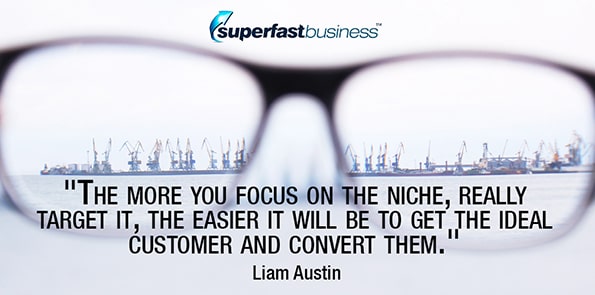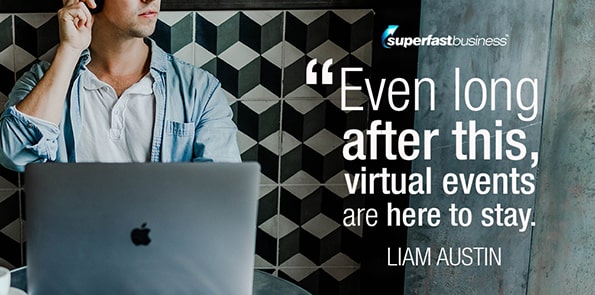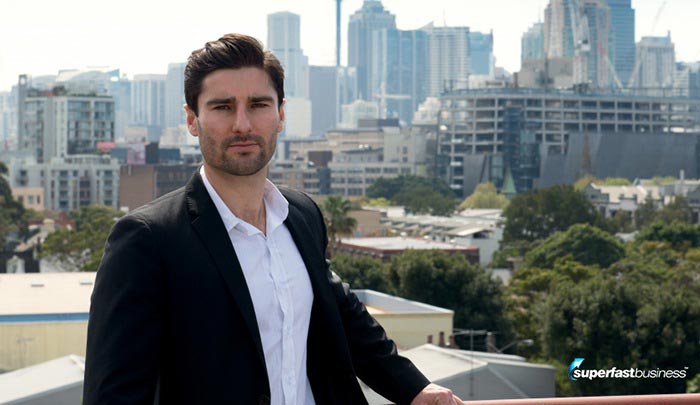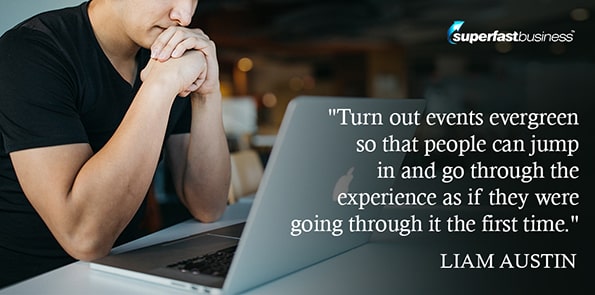Liam Austin of Entrepreneurs HQ has been organizing and holding very successful events online since 2015.
How has the space changed since then, especially now that virtual is the norm? And what pointers can he offer to others looking to hold their own online events?
Liam shares his experience and knowhow in this timely interview.
Podcast: Download (Duration: 33:36 — 30.9MB)
Get Notified Of Future Episodes Apple Podcasts | Spotify | Amazon Music | Android | Blubrry | Gaana | TuneIn | Deezer | Anghami | RSS | More
In the episode:
02:16 – Five years of live online events
03:55 – Why the virtual route?
05:04 – A highly leverageable option
06:55 – Linkedin groups then and now
08:50 – A basic online event model
12:20 – What’s changed in the space?
13:44 – The done-for-you solution
14:38 – Evergreen lead gen machines
16:32 – How to follow up with offers
17:58 – What about the financial pay-off?
19:14 – The sort of technology involved
21:16 – All you need in one place
25:14 – How to succeed on a smaller scale
27:06 – The power of repurposed content
29:02 – Where the speakers come from
30:30 – The top three things to remember
Keep up with what’s currently working in business with James’s help
Transcription:
James: James Schramko here. Welcome back to SuperFastBusiness.com. This is Episode 745, and we’re going to be talking about running online events. Again, I know we’ve been covering this episode a little bit. We’ve talked about live streaming, we’ve talked about how you adjust from physical businesses to online businesses. And I thought it would be great to have a chat with one of the members of SuperFastBusiness, who runs these things for a living. But importantly, he’s been doing it for a long time. So I’d love to welcome Liam Austin. Welcome to the call.
Liam: Cheers, James. Yeah, I feel like I’ve been living and breathing this now since 2015. And there’s certainly been a shift which is, I think, a good thing.
James: Well, it’s a necessary thing, isn’t it? It’s happening. I can relate somewhat because, you know, I wrote a book called Work Less Make More, pretty much documented my change from having a job as a general manager 11 years ago, 2008 actually, it’s even longer. I’ve got to adjust that. I’ve got to get a new story. 2008, I quit my full time job, I went to work online. And I’ve pretty much been living a life of hanging out at home without an office and operating online with online customers. And I’ve been traveling around a little bit in that role.
So the main thing that’s changed for me is just a little less travel, but it’s like the whole world has discovered what I’ve been up to, this reality that you can operate a virtual business, that you can still get things done. I’m wondering now what’s going to happen in the future? Will people go back to co-working space? Will they go back into an open plan office? Will they get into an elevator with 15 people?
Five years of live online events
Obviously, a lot of people have come into your space where you’ve been running these online events quite happily with very little competition. And now everyone’s doing it. What does this actually mean for you? And what advice do you have for other people? That’s what I want to cover in this episode. But I think a good starting point is, what have you been doing up until 2019? What was your business model?
Liam: Sure. So our very first event was 2015. It was the LinkedIn Success Summit. So bringing together 35 LinkedIn experts, how to generate leads from LinkedIn. So most people were small business owners, entrepreneurs, just figuring out the platform, trying to prospect on it. And all those sessions, all 35 sessions, were all pre-recorded. We did, I think, two live components to the event itself. And that was back in 2015.
And over the last few years, we’ve been testing different elements to make it a bit more interesting for people by adding more live elements, such as live Q&A’s, live presentations, even live panel discussions. And even more recently, the technology has been enabling us to actually network between attendees. Zoom has breakout rooms, but there’s other technologies now that are specifically built for virtual conferences, virtual summits, which allow really engaging networking between attendees so that we can almost recreate the in-person experience, but online. I mean, maybe 80 percent of that can be recreated, and then how do we just elevate the experience and do things online that would be impossible to even be doing in person?
Why the virtual route?
James: Why did you do it online instead of running events in conferences, physical events?
Liam: Yeah, so I’m Australian. When I started the business, I was in Sydney, met a partner who was from Sweden. We wanted to travel and move between both countries. So we realized we need to create an online business. So it started with a LinkedIn group that I own, which at the time had around just under 100,000 people. And I surveyed them, asked them what they needed. And they just said they wanted to connect, funnily enough, even though they’re on LinkedIn, and learn from each other.
So we started doing these individual webinars on a weekly basis, and the ones that performed the best were on the topic of LinkedIn. So I just decided, why don’t we just bring all these experts together under one roof, into, like, a festival, into a party, into a conference, and make it the biggest event in this topic of the year. And fair enough, we had 15,000 people attend that event online, which would have been, you know, almost impossible for me just starting out, you know, hiring what, a football stadium or something to get that many people in would have almost been impossible. So that’s what really got us started with the online component.
A highly leverageable option
And now we’re seeing, you know, people moving online or considering adding new online revenue streams, or if they’re an online business, creating new revenue streams via these virtual events. And looking at our clients that are moving from an in-person event or just adding this online component to their business, we’re seeing an increase in the attendance rate compared to their normal in-person event, increasing by three to four times, which means if they were doing a 100 or 200-person in-person event, they were increasing it to 300 to 400 people instead of the 100 they were getting in person.
“The increase in reach and amount of leads generated make online events a really good option.”
So just the increase in the reach that you can have and the amount of leads generated for your business, especially if you do have a business that’s able to sell international with international clients, then it is a really good option.
James: Yeah, look, I think it’s really interesting. I used to do some online events back in 2009, 2010. And then I went to the online space. I’m like, I can reach people with a webinar. I can do a podcast. I love this podcast.
I mean, what you said is just so true, a football stadium. And there are people in our industry, or one or two in particular, who do fill football stadiums with events. But oh my God, what a nightmare in terms of sales, requirements, logistics, you know, hanging your pants out for being on the hook to a venue and and the physical location aspect of it. It’s really next level stuff when you’re running in-person events. I do one in-person event each year in Sydney, usually. And I do one in-person event in the Maldives each year. And that’s enough events for me. I’ll occasionally do a little workshop with five people or whatever.
But the online stuff is just infinitely leverageable. And also, I think it appeals if you have an international audience, and it sounded like your need in the beginning with that LinkedIn group is you would have had people from all different places in that group. So it automatically makes it more logical to have this online.
Linkedin groups then and now
I can’t resist the temptation to ask you. What changes have you seen with LinkedIn since when groups were a thing to now where it’s pretty much the cold contact prospecting machine that it is? I’ve had a few guests on this episode lately about LinkedIn and how it’s changed. But what have you seen, being more of a pioneer? And I wonder if you still even use it now?
Liam: Yeah, so 2008 was when I started the group. LinkedIn first allowed you to create groups on LinkedIn. So I think I got in there early. I did some SEO on the page, just enabled us to be found at the very top of those searches on LinkedIn. And now we’re at 200,000 members. So small business owners, and as you said, most of them are in the US. So that’s why we really focused our business even today on the US market. But I’m living in Malta in Europe right now.
So it’s an interesting one, because when LinkedIn first created the groups, there was stats, there was data around the members, there was a lot more options to be able to contact, connect, reach out to your members. And now they’ve started taking those things away. Why, I don’t know – maybe it’s just not a revenue earner for them. I mean, they’re focused on the recruitment, HR kind of market. So unfortunately, groups have taken a back step and there’s always a rumor or two that they’re going to do something big and do something new, but whenever they do, it seems to be something quite small. So the one thing that we can do really with our groups now is just, as the owner or as an admin of that group, you’re allowed to individually message those groups. So I think that’s where LinkedIn is right now. It’s about the inbox, it’s about individual messaging. And as you said, you know, prospecting people individually.
James: Yeah. So in summary, there was a heyday with groups and now it’s not what it used to be. I was told, don’t bother doing a group, don’t even bother with a company page. It’s all about the personal connections and connecting, which is interesting.
A basic online event model
So you went off and started EntrepreneursHQ.com. It’s like you’re asking for spelling trouble when you have a domain like that. I remember Yaro Starak, who had a hyphenated entrepreneur domain at one point, and then I think he changed himself to Yaro, which was much easier to spell. So on that, I mean, you’ve invited me to be an attendee of one of your events or to contribute some of the content. And you were quite ahead of the curve. You would record the interview, you would then get it turned into a digestible training, and then you’d run it, you’d build up an audience for it, they’d go through it, they could option to buy things. I’d love you to talk me through the basic model that you had for this, for running an event. You know, whether you call it a summit or an online event, or whatever else they call them these days, what was your model?
“It’s all about the end goal – what do you want to achieve off the back of your event?”
Liam: Sure. So for us, it’s all about the end goal. So keeping the end goal in mind, for ourselves and for our clients. I mean, I’ve hosted 17 of these 20-plus-speaker, virtual conferences, myself and many of our clients and had over 100,000 people come through these events. So we’ve tested a lot of things to see what works and what doesn’t. It’s all about having that end goal in mind – what do you want to achieve off the back of your event? Do you have a high-ticket offer? A membership? Like, what is it that you want to ultimately sell – that offer, that product, that service – with all those leads that are going to come from the event?
Once we know what that product is, it’s validated, it’s selling, we know our ideal target customer, we can then reverse engineer the funnel to actually craft the event itself. So we’re looking at, you know, the naming, the positioning, how many days, what components or format do we use? Is it live, is it recorded, are there networking events, all the way through to the actual agenda, so the schedule of the event. So every single session, we can be thinking about and planning, well, what do we want to cover, so that each step along the way leads them closer to buying our high-ticket offer off the back of the event?
So once we’ve got our schedule, we can then look at, okay, well who do we want to invite to speak on these different topics, invite them to be involved as a speaker or as a host of a panel discussion, whatever it might be. And we can pre-record them, we can invite them to do live. But the event that we normally run is a five-day conference. And we look to have at least between 20 to 40 speakers, seems to be the sweet spot in terms of just being able to position this as the biggest event happening in the niche, in the market, in the next 12 months.
And it’s all the very top influencers collaborating, being involved. Like, never before have these people been under one roof providing so much valuable content and information that it’s, when people see it, and it’s marketed, it’s like it’s a no-brainer, you can’t be missing this. If I’m missing it, I’m the only one not going to this event and I’m going to miss maybe discussions or other opportunities that may come from it.
“Design the experience so that when people come into the funnel, it is the perfect ideal customer.”
So once we’ve positioned the event to really stand out, because yeah, there’s a lot of virtual events happening in the market and there’s a lot of competition, so now you really need to raise the bar, raise the game with that. So we want to design the experience so that when people come into the funnel, it is the perfect ideal customer. They then go through the experience of the event, building your rapport as the host, getting to know you if they’ve never met you before, building that know, like and trust factor across those, say, five days, so that by the time they come out of it into the next funnel, they’re just like red hot, they’re warm leads. They’re ready to take that next step with you because you’ve crafted that funnel, that process, so that they just go through off the back end of the summit just ready to buy your high-ticket offer.
What’s changed in the space?
James: And in the last few months, have you had a big change in the market in terms of how many people are doing these things?
 Liam: Yeah. There’s a lot more, and it’s interesting because it’s easy to get started, right? It’s a low barrier to entry to start these virtual events, virtual conferences. So there’s some people that are throwing them together that maybe aren’t thinking it through or are delivering a bad experience for people, and that is not helping their brand or even just those leads coming through. They’re leaving money on the table. I think if you’re going to do a virtual event, make sure you make it into, you know, the biggest event, festival, party that your niche has ever seen, or in the next 12 months is the biggest event of the year. So that it does stand out, so that all the work you do on the copy, on designing the website, on the emails, I mean, you do all that once, so you might as well do it well and drive as many people to your event as possible. Give them a great experience so that you get a high conversion rate, on the, say, that all-access pass during the event, but also off the back end with the high-ticket offer.
Liam: Yeah. There’s a lot more, and it’s interesting because it’s easy to get started, right? It’s a low barrier to entry to start these virtual events, virtual conferences. So there’s some people that are throwing them together that maybe aren’t thinking it through or are delivering a bad experience for people, and that is not helping their brand or even just those leads coming through. They’re leaving money on the table. I think if you’re going to do a virtual event, make sure you make it into, you know, the biggest event, festival, party that your niche has ever seen, or in the next 12 months is the biggest event of the year. So that it does stand out, so that all the work you do on the copy, on designing the website, on the emails, I mean, you do all that once, so you might as well do it well and drive as many people to your event as possible. Give them a great experience so that you get a high conversion rate, on the, say, that all-access pass during the event, but also off the back end with the high-ticket offer.
James: I’m worn out thinking about that. It sounds like such a massive amount of energy for a one-time thing, you know? Like, as someone who doesn’t do product launches, who doesn’t run webinars, doesn’t even go on summits as a guest because it’s a pain in the ass generally. I did say yes to you because you do differentiate how you’re going to position the guests. You do make it an easy experience. But for the most part, I’ve avoided them.
The done-for-you solution
What about if you’re just not an entertainer, like me? What if you just think, Oh, that sounds like a big effort. Are there people out there who can organize this for you?
Liam: Yeah, sure. I mean, we actually partner with people and select clients to launch a business off the back of a virtual summit. So actually combining a virtual summit with a high ticket offer. And you don’t necessarily have to have a high-ticket offer. We can help craft and create one for you. But if we can combine, like, a high-ticket offer, I’m talking about like a 10K-plus offer, it means that we can really scale a business from that. So if we have a 10K offer, we can make 100 sales of that offer, we can make ourselves a million dollars.
So I think it’s really important that we select the right partners to fulfill that, because there is a lot of energy, effort, time taken to actually plan this, but also do the tech, the design of it, and do the copywriting for the pages as well as the funnel.
Evergreen lead gen machines
But one thing you mentioned that I just want to point out, James, is that in terms of a one-time effort, I mean, we turn out events evergreen so that people can jump in and go through the experience as if they were going through it the first time. Now, the live elements are pre-recorded now, because it was done maybe, you know, a few months ago or a year ago when that new person comes into the funnel after it’s been turned evergreen. But we let them know that. We let them know that it’s an experience that they can go through at any time similar to how people do these evergreen webinars.
James: On-demand webinars.
“Create something that can bring in leads forever as long as the content is evergreen.”
Liam: Yeah, exactly. So as an example, I mean, for our LinkedIn summit that I mentioned back in 2015, we first ran it, it’s still generating leads for us every single day, even today. And we’re still making sales from it every week. And when I say a sale, that’s from the all-access pass, people upgrading to that from the event. So we’ve done 17 of these. So we’ve got now 17, like, lead generation machines out there, just driving people into our funnel. And the great thing about these summits, how we’ve positioned them, is that it’s almost a no-brainer to sign up. We’re seeing anywhere between a 60 to 75 percent opt-in rate from visitors visiting the landing page, to opting in and us grabbing their email address. So that’s a really powerful thing. If we’ve got 100 visitors, we’re getting anywhere between 60 to 75 opt-ins to those pages. Which now that we’ve got, you know, multiple of these things out there, it’s not just a one-off thing that we’re creating, we’re creating something that can bring in leads pretty much forever as long as we make sure the content is, you know, evergreen in itself.
James: Good. You know, I was stirring you, right? And I was setting you up for that answer.
Liam: Love it.
James: I’m known for leveraged payoffs. Do something once, get paid over and over again. That’s why I’m a big fan of any kind of leverage. That sounds like a good plan. And of course, I know you have these things evergreen, because we have private conversations.
How to follow up with offers
I also wonder, do you want to talk about, as someone registers that six or seven out of 10, that sounds good for paid traffic, as long as some of them turn into buyers. And there’s probably a gestation period. Do you have an app cart event? Do they have the option to buy something when they register? How do you pursue them during the event or after the event with offers? I’d love to hear how you do that.
Liam: Yeah, sure. So we have a one-time offer immediately after they register. And that’s at the lowest price. And then there’s a spike in purchasing there. And the other spikes are whenever we do an increase in price. And those increases in prices are tied to the start date of the event. So normally when someone registers, even though it’s evergreen, we do a three-to-seven-day window where, you know, the events coming up. We get them excited, we build the momentum for them about, you know, preparing for this and showing up. And then there’s another price increase just before the event begins, potentially one in the middle, depending on what event and how long it’s running for. And then one post the event as well. So that’s for the high ticket offer. And then as we pull people into the back end and offering the high ticket offer, we want to invite people to a very special masterclass that maybe rounds up the event that helps connect the event to the funnel of our high-ticket offer. So that is the general gist of how we do it. And it’s definitely, the free ticket offer right at the beginning helps bring in those leads.
What about the financial pay-off?
James: So are these things worth it financially for you?
Liam: So interesting question, right? So the first few years, we were just running these virtual summits and I mentioned the LinkedIn one, so I’ll stick with that as a topic. We did 15,000 leads, and we made $50,000USD from the sale of all-access passes, and those all-access passes were about $100USD. So we made 500 sales of those from 15,000 people, so it works out to be a bit about 3 percent conversion rate.
James: Which is probably as good as a regular sales page, you know? Or even double some of the sales pages out there.
Liam: Yeah, yeah. So it’s, I mean, it did okay, right? But we never had that high-ticket offer off the back end. And that’s where I think we failed for a number of years. We launched Virtual Summit Academy, which is a 2K product back in 2018, to put off the back of our events. So people can download the scripts, the templates, go do it yourself. That worked quite well. But now we’ve got our high-ticket offer, which, you know, the starting price of that is $12,500. And we work with you doing done-for-you services to create a business around a virtual summit and high-ticket offer and that is where we’re seeing the biggest growth, the biggest profit drivers, biggest revenue. Because it is a high-ticket offer and it’s definitely high margin for us as well.
The sort of technology involved
James: Nice. Do you want to talk about the technology stack? What sort of pieces are needed to run your own online event?
Liam: Yeah, this is pretty cool. So now, just in the last 12 months, lots of new tech has come out specifically built for your virtual summit, virtual conference. So you don’t need any other tool, apart from maybe somewhere to store your videos. But Vimeo is like a couple of hundred bucks a year. So those are HeySummit, virtual summit software. Airmeet.com is a new one that’s popped up from some really successful entrepreneurs.
And there’s networking speed, business networking, where you spend three to five minutes with the person on the other side of the table, and you meet 10 of these people for five minutes each, that’s 15 minutes. You meet 10 potential prospects, partners, sponsors, investors, whatever it may be. So there’s some cool interactions between attendees technology now out there. So Airmeet’s one of them, Remo.co is another that does that. And there’s some others that are moving and being created as we speak.
But even going as far as, like, Facebook, one of these events could be completely run on Facebook, just making sure that opt-in is still there, we’re collecting the email address. But the event could be just held in a Facebook group and then that Facebook group shut down, post the event, which means maybe we can’t turn that evergreen, but it’s definitely a possibility if someone wants, like, a Lo-fi way of getting started. But the way that we build it for our clients is, and when we started, was using WordPress, so we tie in about 12 different tools to make it happen and to turn the event evergreen by using Deadline Funnel. And it’s a combination of having WordPress plus, or your place to host the site, and an email automation platform or our CRM system, plus a cart to be able to accept purchases. So those three tools or elements really make up the ability for you to run a successful event and accept payments as well.
All you need in one place
James: Cool. So this is where I jump in with our sponsor.
You know, 10XPRO is good for that. The front end, the funnels, the deadline funnels, the replays, the cart, all of that can be handled, and then it just integrates with the CRM of your choice. You can also run live streams in it with, you know, popping buttons and putting chats underneath it, etc, if you want. So I just wanted to point that out for people who are following along to these podcasts, because they’re going to hear it a lot. They’re going to send me an email straightaway, Liam. “Does 10XPRO do that?” “Yes, it does.” We had a previous episode on streaming that covers the technical side.
But I think you’ve mentioned some really great off-the-shelf resources that are going to get an event run. I like what you said, the interaction part. Certainly having attended two Zooms in the last few weeks with other people on it, which were replacements for our regular local meetup, the thing that’s missing is when you’re at that conversation at a table in a pub with eight or 10 or 12 people, you can sort of tune into three or four different conversations nearby, and then direct your focus there, and then you can switch to another conversation. You can have little micro conversations within the big meetup. And I found that Zoom didn’t allow that. It’s like, one person talking at a time sucked. And I’m sure they’ll improve and innovate that.
Today, for the first time when I logged into Facebook, I saw in Messenger it said, Get a room, you know, create a room, and they’ve got their Zoom killer out now. It won’t be long till they’re on this thing with some solutions or the ability to have multi streams happening and recordings and stuff. They seem like they’re going for it.
“No matter what, get people on your email list before you send them off to a platform.”
But I think you said it’s something super valuable, and I’m going to reiterate this in case it was missed. And that is, no matter what, get people on your email list before you send them off to a platform like Facebook or a YouTube Live or a Twitch stream or whatever. Get them on the email first.
Liam: Hundred percent. I think that’s been probably the biggest contributor to our business. I’m a hundred percent behind you with that. And the idea of an all-in-one platform, I think if you’re considering doing a virtual conference or event for the first time, definitely go for an all-in-one platform, it’ll just make your experience so much easier and smoother.
James: And if you’ve been around the industry for a while, you’ll know that often the platform you start with will change at some point. You know, sometimes I keep a platform for a long, long time, 10 years, seven years, six years, but eventually, unless the platform is progressive, or adapts, and unless you stay in the same lane, you might need to try a different solution at some point. I’ve seen, like, the whole journey of WordPress, for example. This is specifically what I’m talking about. WordPress is awesome for the front end, great for blogging and so forth. It just doesn’t work as well when you start adding things to it and putting in plugins and updates and members areas and so forth. That’s where it comes unstuck for me. I never went down that path. As you know, I use a different platform for the back end on my main stream site.
But the newest sites that we’ve put up there, like SuperFastResults.com, all 10XPRO. That’s the only tool we’re using front, back, middle. That’s it. And it’s just the simplest thing ever. And then, you know, the bullsh*t stops, and you have to focus on what really matters. And you also said this, Liam, it’s your offer. If you’ve got a great model and you’re driving all this traffic and you’re collecting the opt-ins, which is already a step above others, but you don’t have an offer that’s deep enough or profitable enough, it can still be sort of ho-hum. You came along, you found a market of people all around the world who wanted to get together, you’ve created a solution, you’ve captured their email, you’ve given them the option to buy something. You’ve given them a great experience, and then you’ve got something more valuable for them and it’s become a rewarding business model. So you’ve nailed it. You’ve captured the lead, you have control. You have created an offer that converts, you’ve learnt and adapted around the technology. Gosh, it’d suck if you’re still just relying on a LinkedIn group for your income, wouldn’t it?
Liam: Definitely.
How to succeed on a smaller scale
James: So if we can’t have the biggest, like the gangbuster event with everyone in the industry, is there any other approach we could take? Because in my case, I’m thinking like a niche topic or something specific, like, you know, spearheading something on memberships, for example, that could that could possibly be smaller with less experts, but really specific. Have you seen success with those sorts of things?
Liam: Yeah, definitely. And there’s so many ways to do these events. They could be, you know, a paid event, like a ticketed event. So there’s no free ticket offer. However, my approach is, let’s get every single person that’s interested onto our email list and into our database. I like the free-ticket offer. So even if it’s just like, there’s a free level, so maybe there’s only four out of the 20 sessions that are free or however you want to position it, like, at least have a free tier so people can test it, try it out and then decide if they want to upgrade. In terms of like, yeah, the smaller events, the more niche you get, the more targeted customer or ideal audience is flowing into your event, the easier it is for you to to upgrade them to your high-ticket offer or your offer on the back end, whatever that may be.
 So I think the more you focus on the niche, really target it, the easier it will be to get the ideal customer and convert them. But what I want to say is that I really love the idea of a big, you know, industry-changing type of event that is maybe an annual event. And then you can do these maybe smaller, more niche topics around that event or do a podcast off the back of the event to continue the conversation. Because if this big-industry event that everyone looks forward to every year, you build a brand around it, right? It keeps bringing in leads for you, even after it’s ended, but there’s fresh content being added annually. Then these smaller events could be continuing the conversation with people and keeping you top of mind for people who have already entered into your funnel.
So I think the more you focus on the niche, really target it, the easier it will be to get the ideal customer and convert them. But what I want to say is that I really love the idea of a big, you know, industry-changing type of event that is maybe an annual event. And then you can do these maybe smaller, more niche topics around that event or do a podcast off the back of the event to continue the conversation. Because if this big-industry event that everyone looks forward to every year, you build a brand around it, right? It keeps bringing in leads for you, even after it’s ended, but there’s fresh content being added annually. Then these smaller events could be continuing the conversation with people and keeping you top of mind for people who have already entered into your funnel.
The power of repurposed content
Another thing that you mentioned earlier on, and I didn’t get a chance to jump in and talk about this, but like, when you create an event, say a 30-speaker conference, we can then break down quotes, certain clips of a minute long, from each of these sessions, so that we’ve got social media content for the next 12 months of the year by just creating one 30-speaker virtual conference, which I think is really powerful, because you’ve now got all the content you need to promote across social media, Facebook, Instagram, LinkedIn, whatever it may be, for the next 12 months. And that’s, you know, something else that’s just taken away that you don’t have to worry about. And I think that’s really powerful, to be able to have access to that content, these industry influencers, and be able to kind of lean on them, leverage their notoriety, and be able to provide content, post your event.
James: Yeah, it’s like what I do with SuperFastBusiness Live, except it’s in-person and much more expensive and logistically awkward. You’ve got to pay up big bucks. I think the person who does the best off my events is probably the venue. Then it’s the merchandise supplier. And, of course, I do end up with great content and we have little clips we can spread for social media and we fill in our forum. And for me, SuperFastBusiness is the place where I sell the content, rather than the old way of DVDs and so forth. And we were going to take the recordings from that event and run a live stream version of it for people who couldn’t come, which is like, everyone other than 200 people in the world. It’s a big available market of people who didn’t see it.
So there are lots of hybrids, I think you said it right. There’s no one particular way to do this. Just take some of the ideas that we’ve talked about. You know, we’ve covered some really great stuff in this – why do them, how they’ve been working for you, what you’ve learned over the long period that you’ve been doing them, what changes you’ve seen as people come into the market, what some of the platforms are, how you can monetize them, how you can partner with them, how you can get them done for you.
Where the speakers come from
Final one: as a promoter, and as a podcast host, I get people all the time wanting to be on my show and they want to speak at my event. Do you get people approaching you to be in your summit, or do you go out and find the people you want, or is there a mixture of both?
Liam: Predominantly, we’re going out there and sourcing our speakers based on, you know, that schedule that we’ve created. We’ve planned out certain topics that we want to cover that takes people one step closer to ultimately buying from us. And then we go out there and actually make a list of potential speakers to cover those topics, and then we reach out to them. However, definitely we’ve got a form on our website now where people can actually request to be a speaker at one of our events. And to be honest, I mean, we look at that, but it’s difficult to maybe bring people from that. It’s a better, easier way for us in terms of planning and making it a coherent content for the attendees by actually reaching out to people who we think are going to fulfill each of those topics.
James: Yeah. Perfect. I find a lot of people who apply are not the ones that I want to put in front of my audience, just because we’ve been known for really curating super high quality, non-pitchy experts who are just good at what they do. They don’t even have to be famous. So they’re not actually looking for opportunities. I have to sometimes reluctantly drag them on the stage. Like, I think every year we have half the speakers or a third of the speakers have never spoken before. So it’s kind of fun breaking rookies onto the market and giving them a platform.
The top three things to remember
So, final tips, Liam, you’ve listened to this podcast for this long for half an hour. And you’re thinking you might pull the trigger and do an event. What would be your top three things someone should keep in mind?
 Liam: I think now’s a great time, and even long after this, virtual events are here to stay. People are used to attending virtual meetings or virtual events. So there’s a big audience out there that are even more willing to attend virtual events. So I think it’s just growing, so go out there and get started with it.
Liam: I think now’s a great time, and even long after this, virtual events are here to stay. People are used to attending virtual meetings or virtual events. So there’s a big audience out there that are even more willing to attend virtual events. So I think it’s just growing, so go out there and get started with it.
The second would be, try to create an event that really stands out, and make it different, make it an experience, make it that festival, that party, that biggest event in your industry so you can just stand out from all the other events being on and and that are competing for your prospect’s attention.
The third one would be, don’t worry about the tech.
James: Yeah.
Liam: That’s a great one. So that all-in-one system, just go with what you know, use an all-in-one system rather than try to tie all these things together. And spend, you know, the 80/20 rule, spend 20 percent of your time on marketing the event, because it doesn’t matter how great the website looks, or the tech you’re using. It doesn’t matter. Like, it’s going to convert still very similar. So just spend most of your time on marketing. And if you can get someone to just do the tech side for you or the actual creation of the event, go for that option and spend your time on spreading the word and getting bums on seats,
James: Perfect. You rounded that episode out lovely. Liam, thank you for coming. It’s nice that I was able to have you on my show for once, after me attending yours. That’s Liam Austin from EntrepreneursHQ.com. Liam, you mentioned to me you’ve got a resource that takes people through how to do these things. It’s on your website. Do you recall the address? We’ll definitely link to it in our show notes.
Liam: Yeah, it’s a 23,000-word really in-depth guide on how to run a virtual summit or a virtual conference for yourself, all the tools, all the tech, all the maybe, mistakes to avoid. So you can grab that, free access, there’s no opt-in, at EntrepreneursHQ.com/summit. And you’ll just be able to go through that 23,000-word guide, and you’re off to the races.
James: Thank you so much. And I appreciate you sharing so generously, and have a great time with your next events. So there’s more competition, but there’s more consumers there to come to consume these events. It’s a whole new era, and you’re in a good position to dominate that. So well done.
Liam: Excellent, James. Well, hopefully I just encourage others to get out there and create better, more beautiful experiences that enable you to create a deeper connection with your audiences.
So guys, if you are running one of these and you’re doing this inspired by James and I’s talk, then yeah, I’d love to hear about it. Just reach out to me on LinkedIn and let me know about it. But yeah, hopefully we’ve inspired some people today, James.
James: I hope so too. Thanks, Liam.
Liam: Cheers, mate.
Need a hand in business?
We have online business coaching options at JamesSchramko (membership).
Liked the show? Leave us a review on iTunes!











Leave a Reply